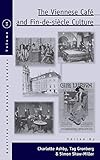The Viennese Café and Fin-de-Siècle Culture / ed. by Charlotte Ashby, Simon Shaw-Miller, Tag Gronberg.
Material type: TextSeries: Austrian and Habsburg Studies ; 16Publisher: New York ; Oxford : Berghahn Books, [2013]Copyright date: ©2013Description: 1 online resource (256 p.)Content type:
TextSeries: Austrian and Habsburg Studies ; 16Publisher: New York ; Oxford : Berghahn Books, [2013]Copyright date: ©2013Description: 1 online resource (256 p.)Content type: - 9780857457646
- 9780857457653
- 647.95436/13 23
- TX907.5.A92 V5488 2013
- TX907.5.A92
- online - DeGruyter
| Item type | Current library | Call number | URL | Status | Notes | Barcode | |
|---|---|---|---|---|---|---|---|
 eBook
eBook
|
Biblioteca "Angelicum" Pont. Univ. S.Tommaso d'Aquino Nuvola online | online - DeGruyter (Browse shelf(Opens below)) | Online access | Not for loan (Accesso limitato) | Accesso per gli utenti autorizzati / Access for authorized users | (dgr)9780857457653 |
Frontmatter -- Contents -- List of Illustrations -- Preface -- Introduction -- 1. The Cafés of Vienna: Space and Sociability -- 2. Time and Space in the Café Griensteidl and the Café Central -- 3. ‘The Jew Belongs in the Coffeehouse’: Jews, Central Europe and Modernity -- 4. Coffeehouse Orientalism -- 5. Between ‘The House of Study’ and the Coffeehouse: The Central European Café as a Site for Hebrew and Yiddish Modernism -- 6. Michalik’s Café in Kraków: Café and Caricature as Media of Modernity -- 7. The Coffeehouse in Zagreb at the Turn of the Nineteenth and Twentieth Centuries: Similarities and Differences with the Viennese Coffeehouse -- 8. Adolf Loos’s Kärntner Bar: Reception, Reinvention, Reproduction -- 9. Graphic and Interior Design in the Viennese Coffeehouse around 1900: Experience and Identity -- 10. The Cliché of the Viennese Café as an Extended Living Room: Formal Parallels and Differences -- 11. Coffeehouses and Tea Parties: Conversational Spaces as a Stimulus to Creativity in Sigmund Freud’s Vienna and Virginia Woolf ’s London -- Notes on Contributors -- Selected Bibliography -- Index
restricted access online access with authorization star
http://purl.org/coar/access_right/c_16ec
The Viennese café was a key site of urban modernity around 1900. In the rapidly growing city it functioned simultaneously as home and workplace, affording opportunities for both leisure and intellectual exchange. This volume explores the nature and function of the coffeehouse in the social, cultural, and political world of fin-de-siècle Vienna. Just as the café served as a creative meeting place within the city, so this volume initiates conversations between different disciplines focusing on Vienna at the beginning of the twentieth century. Contributions are drawn from the fields of social and cultural history, literary studies, Jewish studies and art, and architectural and design history. A fresh perspective is also provided by a selection of comparative articles exploring coffeehouse culture elsewhere in Eastern Europe.
Mode of access: Internet via World Wide Web.
In English.
Description based on online resource; title from PDF title page (publisher's Web site, viewed 25. Jun 2024)


